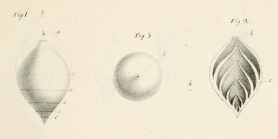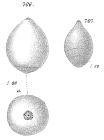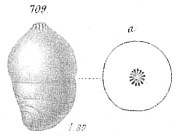WoRMS taxon details
Glandulina laevigata (d'Orbigny, 1826)
113429 (urn:lsid:marinespecies.org:taxname:113429)
accepted
Species
Nodosaria (Glandulina) laevigata d'Orbigny, 1826 · unaccepted (Nomen translatum)
Nodosaria (Glandulina) laevigata var. ovata Cushman & Applin, 1926 † · unaccepted (Subjective junior synonym Opinion...)
Subjective junior synonym Opinion of Le Calvez (1970)
Nodosaria (Glanduline) laevigata d'Orbigny, 1826 · unaccepted (name not available. ICZN Art. 11...)
name not available. ICZN Art. 11 (b)(i): 11 (g): vernacular
Nodosaria laevigata (d'Orbigny, 1826) · unaccepted (type species of Glandulina)
Pseudoglandulina laevigata (d'Orbigny, 1826) · unaccepted (Type species of Glandulina)
Rectoglandulina laevigata (d'Orbigny, 1826) · unaccepted
marine, brackish, fresh, terrestrial
recent + fossil
(of Nodosaria (Glanduline) laevigata d'Orbigny, 1826) Orbigny, A. D. d'. (1826). Tableau méthodique de la classe des Céphalopodes. <em>Annales des Sciences Naturelles.</em> vol. 7: 96-169, 245-314., available online at http://biodiversitylibrary.org/page/5753959
page(s): p. 252 n° 1 pl. 10 fig. 1-3 [details]
(of Nodosaria (Glanduline) laevigata d'Orbigny, 1826) Audouin, J. V.; Brongniart, A. T.; Dumas, J. B. (1826). Atlas des tomes 7, 8, 9. <em>Annales des Sciences Naturelles.</em> , available online at https://www.biodiversitylibrary.org/page/5755704
page(s): pl. 10 fig. 1-3 [details]
page(s): p. 252 n° 1 pl. 10 fig. 1-3 [details]
(of Nodosaria (Glanduline) laevigata d'Orbigny, 1826) Audouin, J. V.; Brongniart, A. T.; Dumas, J. B. (1826). Atlas des tomes 7, 8, 9. <em>Annales des Sciences Naturelles.</em> , available online at https://www.biodiversitylibrary.org/page/5755704
page(s): pl. 10 fig. 1-3 [details]
Hayward, B.W.; Le Coze, F.; Vachard, D.; Gross, O. (2024). World Foraminifera Database. Glandulina laevigata (d'Orbigny, 1826). Accessed through: World Register of Marine Species at: https://www.marinespecies.org/aphia.php?p=taxdetails&id=113429 on 2024-04-19
Date
action
by
![]() The webpage text is licensed under a Creative Commons Attribution 4.0 License
The webpage text is licensed under a Creative Commons Attribution 4.0 License
original description
(of Nodosaria (Glandulina) laevigata var. ovata Cushman & Applin, 1926 †) J. A. Cushman, E. R. Applin. (1926). Texas Jackson Foraminifera. <em>AAPG Bulletin.</em> 10 (2): 154–189., available online at https://doi.org/10.1306/3d93270d-16b1-11d7-8645000102c1865d [details]
original description (of Nodosaria (Glanduline) laevigata d'Orbigny, 1826) Orbigny, A. D. d'. (1826). Tableau méthodique de la classe des Céphalopodes. <em>Annales des Sciences Naturelles.</em> vol. 7: 96-169, 245-314., available online at http://biodiversitylibrary.org/page/5753959
page(s): p. 252 n° 1 pl. 10 fig. 1-3 [details]
original description (of Nodosaria (Glanduline) laevigata d'Orbigny, 1826) Audouin, J. V.; Brongniart, A. T.; Dumas, J. B. (1826). Atlas des tomes 7, 8, 9. <em>Annales des Sciences Naturelles.</em> , available online at https://www.biodiversitylibrary.org/page/5755704
page(s): pl. 10 fig. 1-3 [details]
context source (Deepsea) Murray, J.W. (2006). Ecology and applications of benthic foraminifera. <em>Cambridge, UK, Cambridge University Press.</em> 426pp., available online at http://www.cambridge.org/9780521828390 [details] Available for editors [request]
[request]
context source (HKRMS) Yim, W. W.-S.; He, X.-X. (1988). Holocene foraminifera in Hong Kong and their palaeoenvironmental significance. <em>In: The palaeoenvironment of east asia from the mid-tertiary, Proceedings of the Second International Conference on the Paleoenvironment of East Asia, Vol. II: Oceanography, Palaeozoology and Palaeoanthropology (eds. Whyte, P. Aigner, J.S., Jablonski, N.G., Taylor, G., Walker, D., Pinxian, W. & So, C.-L.), Centre of Asian Studies, University of Hong Kong.</em> 787-809. [details] Available for editors [request]
[request]
basis of record Gross, O. (2001). Foraminifera, <B><I>in</I></B>: Costello, M.J. <i>et al.</i> (Ed.) (2001). <i>European register of marine species: a check-list of the marine species in Europe and a bibliography of guides to their identification. Collection Patrimoines Naturels,</i> 50: pp. 60-75 (look up in IMIS) [details]
additional source Liu, J.Y. [Ruiyu] (ed.). (2008). Checklist of marine biota of China seas. <em>China Science Press.</em> 1267 pp. (look up in IMIS) [details] Available for editors [request]
[request]
new combination reference Orbigny, A. D. d'. (1846). Die fossilen Foraminiferen des tertiären Beckens von Wien. Foraminifères fossiles du bassin tertiaire de Vienne. 312 p., available online at https://archive.org/details/bub_gb_JKpAAAAAcAAJ
page(s): p. 29 pl. 1 fig. 4-5 [details]
original description (of Nodosaria (Glanduline) laevigata d'Orbigny, 1826) Orbigny, A. D. d'. (1826). Tableau méthodique de la classe des Céphalopodes. <em>Annales des Sciences Naturelles.</em> vol. 7: 96-169, 245-314., available online at http://biodiversitylibrary.org/page/5753959
page(s): p. 252 n° 1 pl. 10 fig. 1-3 [details]
original description (of Nodosaria (Glanduline) laevigata d'Orbigny, 1826) Audouin, J. V.; Brongniart, A. T.; Dumas, J. B. (1826). Atlas des tomes 7, 8, 9. <em>Annales des Sciences Naturelles.</em> , available online at https://www.biodiversitylibrary.org/page/5755704
page(s): pl. 10 fig. 1-3 [details]
context source (Deepsea) Murray, J.W. (2006). Ecology and applications of benthic foraminifera. <em>Cambridge, UK, Cambridge University Press.</em> 426pp., available online at http://www.cambridge.org/9780521828390 [details] Available for editors
context source (HKRMS) Yim, W. W.-S.; He, X.-X. (1988). Holocene foraminifera in Hong Kong and their palaeoenvironmental significance. <em>In: The palaeoenvironment of east asia from the mid-tertiary, Proceedings of the Second International Conference on the Paleoenvironment of East Asia, Vol. II: Oceanography, Palaeozoology and Palaeoanthropology (eds. Whyte, P. Aigner, J.S., Jablonski, N.G., Taylor, G., Walker, D., Pinxian, W. & So, C.-L.), Centre of Asian Studies, University of Hong Kong.</em> 787-809. [details] Available for editors
basis of record Gross, O. (2001). Foraminifera, <B><I>in</I></B>: Costello, M.J. <i>et al.</i> (Ed.) (2001). <i>European register of marine species: a check-list of the marine species in Europe and a bibliography of guides to their identification. Collection Patrimoines Naturels,</i> 50: pp. 60-75 (look up in IMIS) [details]
additional source Liu, J.Y. [Ruiyu] (ed.). (2008). Checklist of marine biota of China seas. <em>China Science Press.</em> 1267 pp. (look up in IMIS) [details] Available for editors
new combination reference Orbigny, A. D. d'. (1846). Die fossilen Foraminiferen des tertiären Beckens von Wien. Foraminifères fossiles du bassin tertiaire de Vienne. 312 p., available online at https://archive.org/details/bub_gb_JKpAAAAAcAAJ
page(s): p. 29 pl. 1 fig. 4-5 [details]
 Present
Present  Present in aphia/obis/gbif/idigbio
Present in aphia/obis/gbif/idigbio  Inaccurate
Inaccurate  Introduced: alien
Introduced: alien  Containing type locality
Containing type locality
From editor or global species database
Synonymy Papp and Schmid (1985) put into synonymy the specimens of G. laevigata and G. ovula described by d'Orbigny from the Vienna Basin but not the species described in 1826: "Glandulina laevigata d'ORBIGNY (non 1826)
Plate 2, figs. 1-6
Valid name: Glandulina ovula d'ORBiGNY
1846 Glandulina laevigata d'ORBIGNY; p. 29, Plate 1, figs. 4,5
Reference material: GBA Nr. 1977/01/3
L o c a l i t y : Baden
Rem.: Glandulina laevigata d'ORBiGNY 1826 (recent) has a
distinctly biserial earlier portion of the test. In G. laevigata
d'ORBiGNY 1846 the biserial test is largely reduced.
Specimens corresponding to the typical G. laevigata have
not been described from the Vienna Basin.
Under G. laevigata d'ORBiGNY understands glandulines
from the clay facies of Baden. This is also confirmed by
the material from vial Nr. 3. The test is glassy, thin-shelled
and broad. Vial Nr. 4 (G. ovula) contains more thickshelled,
larger forms which, according to their state of
preservation, originate from marl and sand facies of Nußdorf-
Kahlenberg. Four specimens from vial Nr. 4 originate,
according to their state of preservation, from Baden.
They display the same dimensions as the large
specimens from Nußdorf.
Data on test dimensions reveal an overlapping of the
associations from the clay and marl facies (Fig. 1). Although
morphological differences between the extremes
are quite distinct, in our opinion significant groups do not
emerge; we therefore unite the two species G. laevigata
and G. ovula, differentiated by d'ORBiGNY, and retain G.
ovula as the valid name.
In complete specimens the aperture is radiate, yet
closed; the pores are relatively small (compare Plate 2,
fig. 6)." [details]







